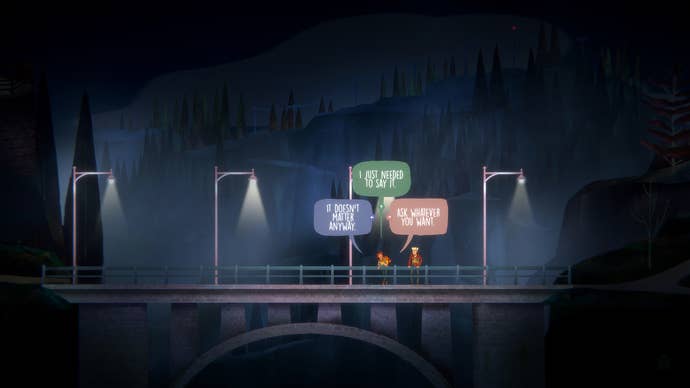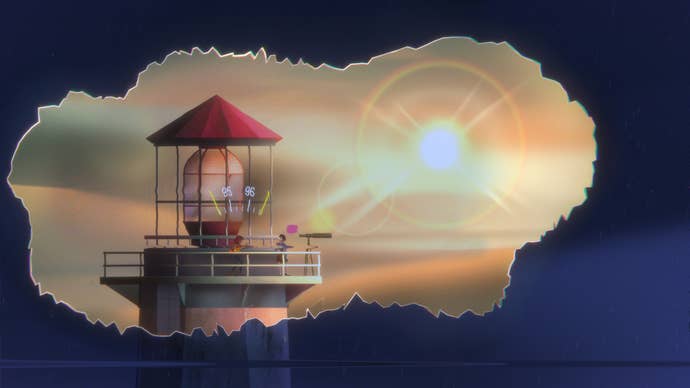Oxenfree 2: Lost Signals is smart. It’s doing something that only games can do, blending the past, present and future in real time. For the past few years, the first game in the series has been projecting sinister and weird messages to players via its in-game radio. If you boot up Oxenfree now, you’ll hear things that weren’t there at launch – aberrant snatches of conversation and schisms in reality that the Parentage (the game’s villains) are supposedly patching in through space, time, and reality.
This is par for the course in Oxenfree, though. The series is only young, but it’s already got a reputation amongst developers and indie game fans as one of the most atmospheric, uneasy narrative experiences of the past generation. It was a story about grief, guilt, and ghosts, that was told through a grounded and innocent lens via a bunch of kids that accidentally stumble upon a phenomenon that no-one could possibly understand.
Oxenfree 2: Lost Signals builds on these solid foundations. Rather than a bunch of kids looking tentatively towards their futures, the sequel begins with a reluctant homecoming. Protagonist Riley Poverly returns to her childhood home to find nothing is quite as she left it – but everything is also sort-of the same. I’m sure any of you that have moved away and been called back for reasons out of your control will know what I mean.

Here, in Oxenfree 2, the game’s cast is older and focuses on people grappling with the decisions they made in their adolescence – not laying down the foundations for the sort of adults they’ll be. Half-remembered acquaintances awkwardly ask if you remember them, unresolved personal dramas you ran away from years ago begin to re-emerge. It’s hard to focus on your job – investigating supernatural phenomena – with all these little problems gnawing at your subconscious.
The game’s structure is somewhat linear to begin, but then starts to open up; plant beacons, report findings, start chatting to the locals and poke your nose into their own uncomfortable lives. The island setting of Camena is a weird place, and it magnetises weird people to it. You can contact them all on your walkie-talkie, or hear about local goings-on via your radio. It’s light on gameplay, and heavy on story – much like the first. But that’s what you want from this; a cerebral and reflective radio drama. All underlined by a great soundtrack (the original Oxenfree has one of the best modern soundtracks in gaming, quote me on that).
This is a game for the sorts of weird nerds that were members of the AV Club, probably written by the sorts of weird nerds that were heads of the AV Club, and the respect and reverence it has for old tech is worn proudly on its sleeve. It’s a quietly sad game for quietly sad people, taking pride in its weird status and really leaning into its niche to provide the sort of storytelling – supported by the sorts of performances – arthouse, black coffee-drinkers will swoon over.

It’s fitting, then, that the game is being broadcast to the masses via Netflix (as was the plan ever since Netflix picked up developer, Night School Studio, back in 2021) . Similarly to the first, it’s coming to PlayStation 5, PlayStation 4, PC, and Nintendo Switch, but anyone with a Netflix account will be able to play it on mobile. This mass, mainstream audience is what I’m hoping will bite. Oxenfree is the perfect series for people that don’t know what games can really do when it comes to story; it’s low-stakes, low-intesnity, story rich, and emotionally rewarding.
It’s a game that understands the pressure of being a confused adult in today’s world. It’s a game that understands what it’s like to exist in a reality that’s under threat – whether that’s by socio-economic uncertainty, climate catastrophe, or a weird gap in space/time eating away the edge of reality. It’s a game that promises to deliver something special, and knows how to get into your head.
If you haven’t played the first one, you’ve got until July 12 to do so. Because you’re not going to want to skip Oxenfree 2 when it launches.

